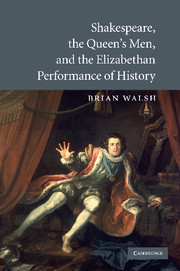Book contents
- Frontmatter
- Contents
- Acknowledgments
- Introduction
- 1 Dialogues with the dead: history, performance, and Elizabethan theater
- 2 Theatrical time and historical time: the temporality of the past in The Famous Victories of Henry V
- 3 Figuring history: Truth, Poetry, and Report in The True Tragedy of Richard III
- 4 “Unkind division”: the double absence of performing history in I Henry VI
- 5 Richard III and Theatrum Historiae
- 6 Henry V and the extra-theatrical historical imagination
- Conclusion: traces of Henry/traces of history
- Bibliography
- Index
2 - Theatrical time and historical time: the temporality of the past in The Famous Victories of Henry V
Published online by Cambridge University Press: 19 January 2010
- Frontmatter
- Contents
- Acknowledgments
- Introduction
- 1 Dialogues with the dead: history, performance, and Elizabethan theater
- 2 Theatrical time and historical time: the temporality of the past in The Famous Victories of Henry V
- 3 Figuring history: Truth, Poetry, and Report in The True Tragedy of Richard III
- 4 “Unkind division”: the double absence of performing history in I Henry VI
- 5 Richard III and Theatrum Historiae
- 6 Henry V and the extra-theatrical historical imagination
- Conclusion: traces of Henry/traces of history
- Bibliography
- Index
Summary
About midway through Robert Greene's Friar Bacon and Friar Bungay, a play staged by the Queen's Men and set largely in Oxford and the English countryside in the thirteenth century, the clown Rafe calls attention to a time and place much closer to the performance at hand. He speaks of sailing a ship of fools “with a fair wind to the Bankside in Southwark,” the location of the Rose Theater where Friar Bacon and Friar Bungay was likely staged originally. The playgoers and players are wryly figured as a community of idiots who spend their time following a disreputable pursuit in a disreputable suburb. Rafe seems to be saying to the assembled crowd: “We're all in this together.” The “this” is the event of theater itself, and in the particular case of Friar Bacon and Friar Bungay, it is a temporally complex event. The play is named for the famed thirteenth-century Franciscan friar Roger Bacon and features King Henry III as well as his son, the future Edward I. In other words, it is set in the historical past. And yet, as Rafe's remarks about the “place of the stage” make clear, it is being performed at the edge of Elizabethan London. The dialectic of the “now” of theater and the “then” of the past is made, for a moment, explicitly clear, and it is no accident that a clown is responsible. Clowning with history is a signature move of the Queen's Men, a move that highlights the temporality and artifice of historical knowledge.
This is most evident in the company's performance of the anonymously authored The Famous Victories of Henry V, first put on sometime in the 1580s.
- Type
- Chapter
- Information
- Publisher: Cambridge University PressPrint publication year: 2009



